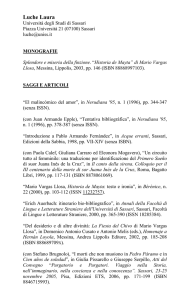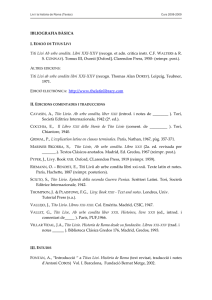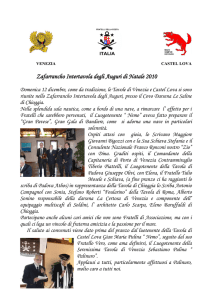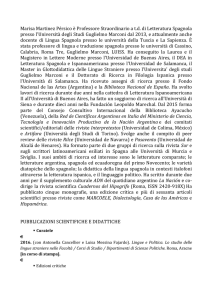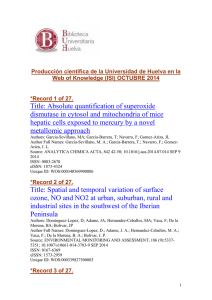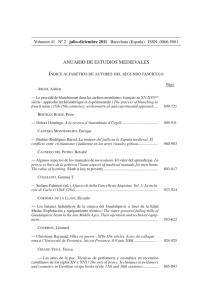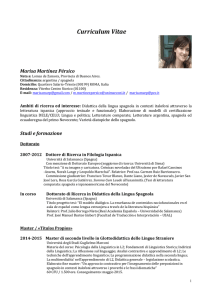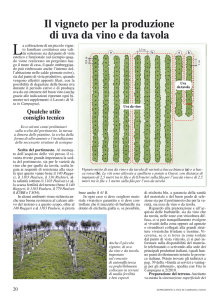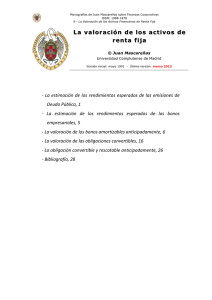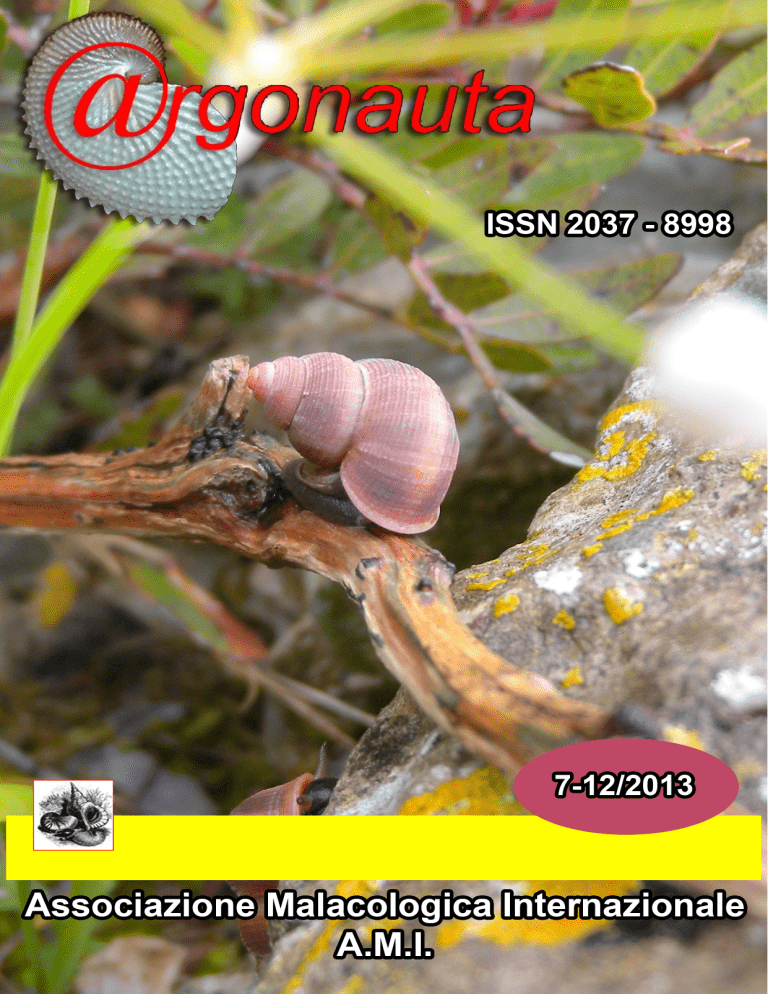
ARGONAUTA International Journal of Malacology 1984 ISSN 2037 - 8998 published by Associazione Malacologica Internazionale (A.M.I.) "Founded to the increase and diffusion of Malacological knowledge" Disclaimer Argonauta is not issued for purposes of zoological nomenclature, in accordance with art. 8.2 of the International Code of Zoological Nomenclature (2012) PUBBLICATO DA: Associazione Malacologica Internazionale (A.M.I.) - Istituto giuridicamente riconosciuto con DM 6.11.1992 dal Ministero per i Beni e le Attività Culturali Redazione: Via delle Case Basse, 171 – 00125 Roma Sede e Biblioteca: Via del Risaro, 29, I-00127 Roma website: www. amimalakos.com e-mail address: [email protected] Aut. Trib. di Roma n. 138/85 dell’8.3.1985 DIRETTORE RESPONSABILE: Roberto Ubaldi PROGETTO GRAFICO ED INFORMATICO: Domenico Ramazzotti FOTOGRAFIE: Alessandro Margelli CONSULENTE EDITORIALE: Roberto Ubaldi La Presidenza del Consiglio dei Ministri ha iscritto al R.N.S. la presente pubblicazione a decorrere del 16.5.1996 (N. 1902. Vol. 20 f. 9 in data 17.5.1986) L'Associazione Malacologia Internazionale nella qualità di Operatore di Comunicazione è iscritta al N. 7321 del ROC dal 30 Novembre 2001 NOTE TO THE AUTHORS Argonauta publishes papers based on original research and review articles on Malacology. Single monographic issues are published occasionally: Authors should contact the Editors for details. Taxonomic papers are to respect both the Articles and Recommendations of the current edition of the International Code of Zoological Nomenclature. particularly when describing new taxa. All articles and associated recommendations of the I.C.Z.N. are to be strictly followed and adhered to (especially Art. 73 and associated recommendations hereof), and the location of all typed material is to be clearly indicated. All papers (which shall include all those of invited contribution), shall be reviewed by a minimum of two referees. All such manuscripts as do not conform to such guidelines as be here indicated below, shall not be taken into consideration. It is required that three copies of all such manuscripts as be submitted, be forwarded to the Editors at the address indicated here below: It is preferable that submitted manuscripts be written in English. Authors of such, are to provide the names and addresses of four research scientists of recognized competence to be considered as reviewers of the submitted material. Reproduction of all figures and illustrations that be under national or international copyright, may be included with, and in, the said articles only if such figures and illustrations be accompanied with the express written permission of the holder of the said copyright or copyrights. The final completed manuscript version of all such works as be accepted, are to be written on digital support or forwarded via e-mail. Both PC or Macintosh formats shall be accepted. It be requested to all authors, not to justify the text submitted, nor the pages, tabulations nor chapter titles thereof. All Latin names, Journal titles and Reference VERSALITAS are to be included in italics. It be required that use is made of one of the more widely used word-processors – e. g. MS-WORD, WORD-PERFECT, or to send a plainly written text ASCII. In this number: Argonauta n. 7-12 year 2013 volume XXII Alessandro Margelli La Famiglia Pomatiidae: un aiuto iconografico e qualche nota utile alla loro identificazione pagg. 001-057 ISSN 2037 – 8996 Vol. XXII n. 7-12/2013 Argonauta ______________________________________________________________________________________________ pag. 1______ La Famiglia Pomatiidae: un aiuto iconografico e qualche nota utile alla loro identificazione. di Alessandro Margelli * Nel mio intento di contribuire alla conoscenza dei molluschi terrestri, senza alcuna intenzione di revisione, ma solo con lo scopo di rendere più facile la loro identificazione, grazie ad una ampia iconografia e poche note esplicative, prendo in esame una Famiglia composta da un numero di specie limitato, ma grazie a studi recenti, abbastanza ben definito. La famiglia fa parte dei Molluschi Prosobranchi, considerati tra i molluschi terrestri più antichi. Sono ascritti a questa Famiglia due Generi: Pomatias e Tudorella con probabili antenati fossili fin dal Miocene, con conchiglia destrorsa, dalla consistenza robusta e con evidenti strie spirali più o meno rilevate e costolatura assiale, sono dotati di opercolo calcareo di forma spirale. In my attempt to contribute to the knowledge of terrestrial molluscs, with no intention of revision, but only with the aim to make it easier to identify them, thanks to an extensive iconography and a few explanatory notes, I examine a Family composed of a number of species limited, but thanks to recent studies, fairly well defined. The Family is part of Prosobranchs Mollusca, considered among the oldest terrestrial molluscs. They are ascribed to this Family two Genera: Pomatias and Tudorella with probable fossil ancestors since the Miocene, with shell clockwise, the texture and robust with obvious spiral striae more or less recognized and axial ribs had a calcareous operculum with spiral form. I molluschi appartenenti a questo gruppo vivono in vari ambienti anche antropizzati. In genere, si rinvengono alla base di rocce e muretti, dove cercano riparo nel substrato, interrandosi ed uscendo in condizioni di forte umidità in ore notturne o subito dopo o durante la pioggia. Hanno una discreta mobilità con andamento particolarmente “barcollante” dovuto al piede diviso longitudinalmente, hanno una lunga e grande proboscide, sono sessualmente distinti ed hanno un leggero dimorfismo sessuale con le femmine leggermente più grandi dei maschi. Le dimensioni della conchiglia sono simili nelle varie specie e si aggirano intorno ai 1518mm con variazioni poco significative. Oggi, secondo gli studi destinati all’analisi di genetica molecolare di Pfenninger et al. (2009), sappiamo che nell’area mediterranea esistono in realtà otto specie, geneticamente distinte, del genere Tudorella, tali conclusioni non sono state però recepite da Bank (2011) e da Francisco Welter-Schultes (2012), che mantengono le denominazioni precedenti pur citando il suddetto lavoro, ma affermando che le specie proposte per l’Europa da Pfenninger et al. (2009), richiedono conferma. _________________________________ * Alessandro Margelli [email protected] Via Cerretti 77 - 56020 Santa Maria A Monte (PI) ISSN 2037 – 8996 Vol. XXII n. 7-12/2013 Argonauta ______________________________________________________________________________________________ pag. 2______ The molluscs belonging to this group live in different environments also humanized . In general , are found at the base of rocks and walls, where they seek shelter in the substrate, and burrowing out under conditions of high humidity at night or immediately after or during the rain. They have a decent mobility with performance particularly "staggering" due to the foot divided longitudinally , have a long proboscis and large , are sexually distinct and have a slight sexual dimorphism, with females slightly larger than males. The dimensions of the shell are similar in the different species and are around 15-18mm with insignificant variations. Today, according to the studies for analysis of the molecular genetics of Pfenninger et al. (2009), we know that in the Mediterranean there are actually eight species, genetically distinct, such Tudorella, but such findings have not been implemented by Bank (2011) and Francisco WelterSchultes (2012) , which maintain the previous names while quoting the above job, but stating that the species proposed for Europe by Pfenninger et al. (2009), require confirmation. Ho adottato le denominazioni proposte da Pfenninger et al. (2009) pur non entrando in merito al fatto che le stesse, o parte di loro, abbiano validità specifica o debbano restare a livello di ssp. Pfenninger et al. (2009), affermano che le specie di Tudorella da ritenere valide siano : I adopted the names proposed by Pfenninger et al. (2009) while not getting over the fact that the same, or part of them, have specific validity or must remain at the level of ssp. Pfenninger et al. (2009) state that the species of Tudorella be considered valid are: Tudorella ferruginea (Lamarck, 1822) delle Isole Baleari. Tudorella mauretanica (Pallary, 1898) della Spagna SE, del Marocco NE e dell’Algeria NO. Tudorella sulcata (Draparnaud, 1805) dell’Algeria NE, della Sardegna e della Francia SE. Tudorella multisulcata (Potiez & Michaud, 1838) della Sicilia occidentale e meridionale . Tudorella panormitana (Sacchi, 1954) della Sicilia settentrionale (Monti di Palermo). Tudorella melitense (Sowerby, 1847) delle Isole Maltesi. Tudorella nov. spec. 1 (aff. multisulcata) della Sardegna occidentale. Tudorella nov. spec. 2 (aff. multisulcata) endemica della penisola Edough nell’Algeria NE. ISSN 2037 – 8996 Vol. XXII n. 7-12/2013 Argonauta ______________________________________________________________________________________________ pag. 3______ Tavola 1 a) Pomatias elegans Cervo (IM). b) Tudorella melitense Malta, Rabat. c) Tudorella multisulcata Cala Rossa, Favignana (TP). d) Tudorella panormitana Monte Gallo (PA). e) Tudorella sulcata Sant'Antioco, Tonnara (CI). f) Tudorella nov. spec. 1 Alghero, Fertilia, Monte Doglia (SS). ISSN 2037 – 8996 Vol. XXII n. 7-12/2013 Argonauta ______________________________________________________________________________________________ pag. 4______ Tavola 2 ISSN 2037 – 8996 Vol. XXII n. 7-12/2013 Argonauta ______________________________________________________________________________________________ pag. 5______ Nella Famiglia Pomatiidae è inclusa, inoltre, Pomatias elegans (Müller, 1774) specie diffusa in tutta l’Italia continentale, nelle isole ed in Europa NW fino alla Turchia ed al N Africa. Fino a qualche anno fa, le specie oggi appartenenti a Tudorella erano, talora, attribuite a Pomatias e considerate ssp. di sulcata ( Draparnaud, 1805). In the Family Pomatiidae is included also Pomatias elegans (Müller, 1774) species spread throughout mainland Italy and the islands in NW Europe to Turkey and the N Africa. Until a few years ago, today the species belonging to Tudorella were sometimes attributed to Pomatias and considered ssp. sulcata (Draparnaud, 1805). Lo Brano & Sparacio (2006) ritengono valide le osservazioni di Sacchi (1954) che le aveva descritte come distinte sottospecie e dimostrano, su base anatomica, la distinzione di T. panormitana (Sacchi, 1954) da T. sulcata (Draparnaud, 1805), mantengono però la denominazione T. sulcata (Draparnaud, 1805), per l’altra specie di Tudorella siciliana e solo a seguito del lavoro di Pfenninger et al. (2009) tale specie viene elevata a specie valida e denominata Tudorella multisulcata (Potiez & Michaud, 1838). Lo Brano & Sparacio (2006) considered valid observations of Sacchi (1954), who had described as subspecies and demonstrate, on the basis of anatomical distinction of T. panormitana (Sacchi, 1954) by T. sulcata (Draparnaud, 1805), however, maintain the name T. sulcata (Draparnaud, 1805), for the other species of Tudorella Sicilian and only after the work of Pfenninger et al. (2009) this species is elevated to valid species and named Tudorella multisulcata (Potiez & Michaud, 1838). Liberto et al. (2010) riportano, finalmente, per la Sicilia le tre specie valide della Famiglia Pomatiidae con le denominazioni attuali. La specie sarda risultata valida e, al momento, identificata come nov. spec. 1 da Pfenninger et al. (2009) non è stata praticamente ancora descritta . Alzona (1971) riporta Pomatias sulcatus reticulatus Kobelt, 1879 pag. 48 fig. 1666. L’illustrazione relativa e la descrizione però sembrano appartenere in maniera inequivocabile a T. sulcata, pertanto l’uso della denominazione di Kobelt non può essere utilizzata per la specie sarda identificata come nov. spec. 1 da Pfenninger et al. (2009) Liberto et al. (2010) report, finally, to Sicily, the three valid species of the Family Pomatiidae with the present names. The Sardinian species proved valid and, at the time, identified as nov. spec. 1 from Pfeninger et al. (2009) has not been described yet practically. Alzona (1971) reports Pomatias sulcatus reticulatus Kobelt, 1879 p. 48 fig. 1666. The illustration and its description, however, seem to belong unequivocally to T.sulcata, so the use of the name Kobelt can not be used for the Sardinian species identified as nov. spec. 1 from Pfenninger et al. (2009) In Sardegna si rinviene anche Tudorella sulcata (Draparnaud, 1805) oltre alla comune Pomatias elegans (Müller, 1774). A Malta Pomatias elegans ( Müller , 1774 ) si rinviene solo in un giardino pubblico e potrebbe essere, secondo Giusti et al. (1995), un apporto antropico recente mentre quella che era ISSN 2037 – 8996 Vol. XXII n. 7-12/2013 Argonauta ______________________________________________________________________________________________ pag. 6______ ritenuta al più ssp. di Tudorella sulcata (Draparnaud, 1805), la si rinviene in tutto l’arcipelago maltese, ma è considerata oggi specie distinta col nome di Tudorella melitense (Sowerby, 1847). In Sardinia is found also Tudorella sulcata (Draparnaud, 1805) in addition to the common Pomatias elegans (Müller, 1774). In Malta Pomatias elegans (Müller, 1774) is found only in a public garden and could be, according to Giusti et al. (1995), a recent anthropogenic inputs while what was considered the most ssp. of Tudorella sulcata (Draparnaud, 1805), is found throughout the Maltese Archipelago, but is now considered a distinct species under the name of Tudorella melitense (Sowerby, 1847). In definitiva ad oggi possiamo considerare che in Sicilia si rinvengono tre specie distinte: Tudorella multisulcata (Potiez & Michaud, 1838), Tudorella panormitana (Sacchi, 1954) e Pomatias elegans (Müller, 1774) delle quali le prime due sono endemiche. In Sardegna si trova Pomatias elegans (Müller, 1774) e altre due specie, Tudorella nov. spec. 1 (aff. multisulcata), endemica, e Tudorella sulcata (Draparnaud, 1805). Nell’Italia continentale l’unica specie che si rinviene è Pomatia elegans (Müller , 1774) mentre Tudorella sulcata (Draparnaud, 1805), che si trova in Sardegna e riappare anche nel sud della Francia, non sembra presente entro il confine italiano. Lo scopo di questo mio lavoro è destinato ad illustrare le specie italiane e quella maltese unitamente ad una ricca iconografia per renderle facilmente distinguibili. La distinzione derivata dagli studi molecolari di Pfenninger et al. (2009) risulta, a mio parere, salvo quanto sopra affermato, di chiara e comprensibile lettura , priva di dubbi e perplessità, salvo alcune considerazioni esclusivamente morfologiche. Nota: I numeri che seguono il nome specifico e la località di reperimento sono riferiti alla collocazione degli esemplari nella mia raccolta. Ultimately, today we can consider that the three species are found in Sicily distinct Tudorella multisulcata ( Potiez & Michaud, 1838) , Tudorella panormitana ( Sacchi, 1954) and Pomatias elegans ( Müller, 1774) of which the first two are endemic. In Sardinia is Pomatias elegans ( Müller, 1774) and two other species, Tudorella nov. spec. 1 ( aff. multisulcata ), endemic, and Tudorella sulcata ( Draparnaud, 1805). In the Italy Continental are the only species that is found is Pomatia elegans ( Müller, 1774) while Tudorella sulcata ( Draparnaud, 1805), which is found in Sardinia and also reappears in the south of France, this does not appear within the Italian border. The purpose of this work is intended to show that Italian and Maltese species, together with a rich iconography to make them easily distinguishable. The distinction comes from molecular studies of Pfenninger et al. (2009 ) is, in my opinion, except as stated above, in clear and understandable reading, devoid of doubts and perplexity, except for some morphological considerations only. Note: The numbers that follow the specific name of the location of retrieval are related to the placement of the specimens in my collection. ISSN 2037 – 8996 Vol. XXII n. 7-12/2013 Argonauta ______________________________________________________________________________________________ pag. 7______ Pomatias elegans (Müller, 1774) La prima specie, Pomatias elegans (Müller, 1774), è ampiamente diffusa su tutto il territorio italiano e sulle isole: è quella che si rinviene fino negli ambienti più antropizzati, nei giardini, negli orti e, ovviamente, anche in ambienti più naturali. E’ specie conosciutissima, facilmente visibile, specie dopo la pioggia, non ha una grande variabilità morfologica né cromatica, tuttavia se ne possono incontrare popolazioni con leggere differenze. The first species, Pomatias elegans (Müller, 1774), is widely distributed throughout the Italian territory and islands: it is that which is found up in the most humanized, in gardens, in the vegetable gardens and, of course, in most natural environments. And 'well known species, easily visible, especially after the rain, does not have a great morphological variability or colour, however you can meet people with slight differences. La scultura è poco accentuata, le coste spirali sono quasi sempre più grandi delle assiali e pressoché uguali fra loro, le assiali, più esili in genere, possono talora essere più grandi e quasi identiche a quelle spirali. La spaziatura è regolare e l’incrocio fra coste assiali e spirali genera piccolissimi noduli ed una trama omogenea che conferiscono alla superficie un aspetto granuloso ma regolare . La colorazione è quasi sempre su base grigia, ma con esemplari che si presentano talora color prugna specialmente nella protoconca e sulle macchiette talora, molto numerose disposte a formare delle fasce. Nelle tavole che seguono mostro alcuni esemplari provenienti da varie località. In ordine da sinistra verso destra e dall’alto verso il basso: The sculpture is not very pronounced, the coasts of spirals are almost always larger than the axial and almost equal to each other, the axial thinner in general, can sometimes be larger and almost identical to those of spirals. The spacing is regular and the intersection between the coast and axial coils generate small nodules and a smooth texture that give the surface a grainy but smooth. The coloring is almost always gray base, but with specimens that occur at times especially in the plum-colored specks on the protoconch and at times, very many arranged to form bands. The following tables show some examples from various locations. In order from left to right and from top to bottom: - 1) Urì (SS) 0016 - 2) Alberobello (BA) 0371 - 3) Saorge, Francia 0417 - 4) Volterra (PI) 0714 - 5) Ittiri (SS) 3235 - 6) Soave (VR) 3664 Tavola 3 - frontale Tavola 4 - retro Tavola 5 – apex Tavola 6 – base Tavola 7 – laterale Table 3 - front Table 4 - back Table 5 - apex Table 6 - base Table 7 – lateral ISSN 2037 – 8996 Vol. XXII n. 7-12/2013 Argonauta ______________________________________________________________________________________________ pag. 8______ Tavola 3 ISSN 2037 – 8996 Vol. XXII n. 7-12/2013 Argonauta ______________________________________________________________________________________________ pag. 9______ Tavola 4 ISSN 2037 – 8996 Vol. XXII n. 7-12/2013 Argonauta ______________________________________________________________________________________________ pag. 10______ Tavola 5 ISSN 2037 – 8996 Vol. XXII n. 7-12/2013 Argonauta ______________________________________________________________________________________________ pag. 11______ Tavola 6 ISSN 2037 – 8996 Vol. XXII n. 7-12/2013 Argonauta ______________________________________________________________________________________________ pag. 12______ Tavola 7 ISSN 2037 – 8996 Vol. XXII n. 7-12/2013 Argonauta ______________________________________________________________________________________________ pag. 13______ Un secondo gruppo di esemplari di Pomatias elegans da altre località: A second group of specimens of Pomatias elegans from other locations: 1) Cervo IM (IM) 3865 2) Tindari (ME) 3922 3) San Vito Lo Capo (TP) 3924 4) Cirella (CZ) 4119 5) Torano Piastra (CS) 5350 6) Argentario Porto Ercole (GR) 4148 Illustrati da una serie di vedute Tavola 8 Tavole 9 Tavola 10 Tavola 11 Tavola 12 - frontale - retro - apice - base - laterale _____________________ _________________________ ISSN 2037 – 8996 Vol. XXII n. 7-12/2013 Argonauta ______________________________________________________________________________________________ pag. 14______ Tavola 8 ISSN 2037 – 8996 Vol. XXII n. 7-12/2013 Argonauta ______________________________________________________________________________________________ pag. 15______ Tavola 9 ISSN 2037 – 8996 Vol. XXII n. 7-12/2013 Argonauta ______________________________________________________________________________________________ pag. 16______ Tavola 10 ISSN 2037 – 8996 Vol. XXII n. 7-12/2013 Argonauta ______________________________________________________________________________________________ pag. 17______ Tavola 11 ISSN 2037 – 8996 Vol. XXII n. 7-12/2013 Argonauta ______________________________________________________________________________________________ pag. 18______ Tavola 12 ISSN 2037 – 8996 Vol. XXII n. 7-12/2013 Argonauta ______________________________________________________________________________________________ pag. 19______ Tudorella nov. spec. 1 da Pfenninger et al. (2009) La specie sarda indicata come nov. spec. 1, è distribuita solo in Sardegna occidentale. Avevo da tempo notato la sua diversità dalle forme di Tudorella sulcata (Draparnaud, 1805) proprio per una scultura molto meno esasperata, sia pure ben evidente, e anche per una certa costanza di presenza di bande più scure su base aranciata. I cordoni spirali sono quasi uguali fra loro, più numerosi che in Tudorella sulcata (Draparnaud, 1805), regolarmente distanziati, al loro incrocio non si formano noduli ma solo leggere protuberanze . Ho rinvenuto tale specie sulle colline nei dintorni di Alghero, in numero notevole, alla base di rocce calcaree e, dopo la pioggia, mi è capitato di trovarne dozzine sul manto asfaltato di alcune strade. Nei pressi di Urì(SS) la specie convive con Pomatias elegans (Müller , 1774) anche qui ho rinvenuti numerosi esemplari di entrambe le specie. Sempre nell’ordine da sinistra a destra e dall’alto in basso ecco alcune tavole iconografiche: The Sardinian species listed as nov. spec. 1, is distributed only in Western Sardinia. I had long noticed its diversity from the forms of Tudorella sulcata (Draparnaud, 1805) just for a sculpture much less exasperated, albeit well evident, and also for a certain constancy of the presence of bands on the basis darker orange. The cords spirals are almost equal to each other, more numerous than in Tudorella sulcata (Draparnaud, 1805), regularly spaced, at their intersection does not form nodules but only read protuberances. I found this species in the hills near Alghero, in substantial numbers at the base of limestone and, after the rain, I happened to find dozens on the mantle of some paved roads. Near Uri (SS) species coexists with Pomatias elegans (Müller, 1774) here I found numerous specimens of both species. Always order from left to right and top to bottom, here are some iconographic tables - 1) Urì (SS) 0015 - 2) Urì (SS) 0015a - 3) Urì (SS) 0015b - 4) Buggerru (CI) 7854 - 5) Alghero, Fertilia, Monte Doglia (SS) 7877 Tavola 13 - frontale Table 13 - front Tavole 14 - retro Table 14 - back Tavola 15 - apex Table 15 - apex Tavola 16 - base Table 16 - base Tavola 17 - laterale Table 17 – lateral ISSN 2037 – 8996 Vol. XXII n. 7-12/2013 Argonauta ______________________________________________________________________________________________ pag. 20______ Tavola 13 ISSN 2037 – 8996 Vol. XXII n. 7-12/2013 Argonauta ______________________________________________________________________________________________ pag. 21______ Tavola 14 ISSN 2037 – 8996 Vol. XXII n. 7-12/2013 Argonauta ______________________________________________________________________________________________ pag. 22______ Tavola 15 ISSN 2037 – 8996 Vol. XXII n. 7-12/2013 Argonauta ______________________________________________________________________________________________ pag. 23______ Tavola 16 ISSN 2037 – 8996 Vol. XXII n. 7-12/2013 Argonauta ______________________________________________________________________________________________ pag. 24______ Tavola 17 ISSN 2037 – 8996 Vol. XXII n. 7-12/2013 Argonauta ______________________________________________________________________________________________ pag. 25______ Tudorella sulcata (Draparnaud, 1805) Tudorella sulcata (Draparnaud, 1805) sembra essere localizzata, per il territorio italiano, esclusivamente in Sardegna. Gli esemplari da me trovati non sono moltissimi, la maggior parte di essi sono stati da me rinvenuti nella zona sud e centro occidentale dell’isola ed in prossimità della costa. La scultura è accentuata, con cordoni spirali rilevati in numero di 8-10 ed intervallati, non sempre, da cordoncini spirali decisamente più piccoli e da numerosi cordoncini assiali. La maggior parte dei miei esemplari sono stati da me rinvenuti sotto pietre nelle retro dune in zone dalla scarsa vegetazione e piuttosto aride, prevalentemente nella zona di Is Arutas(OR) e di Sant’Antioco(CI), più raramente ho rinvenuti esemplari nell’entroterra, a Laconi e ad Isili(OR). Come di consueto alcune tavole iconografiche: Tudorella sulcata (Draparnaud, 1805) seems to be localized to the Italian territory, only in Sardinia. The specimens found by me are not very many, most of them were found by me in the south and central-west and near the coast. The sculpture is accented with beads spirals detected in the number of 8-10 and spaced out, not always, be significantly smaller spiral cords and numerous axial cords. Most of my specimens were found under stones by me in the back dune areas in the rather arid and sparsely vegetated, mainly in the area of Is Arutas (OR) and S. Antioco (CI), the more I have rarely found in specimens' inland, in Laconi and Isili (OR). As usual some iconographic tables: - 1) Laconi (OR) 4454 - 2) Is Arutas (OR) 7768 - 3) Is Arutas (OR) 7768a - 4) Is Arutas (OR) 7768b - 5) Is Arutas (OR) 7768c - 6) Sant'Antioco, Tonnara (CI) 8261 Tavola 18 - frontale Table 18 - front Tavole 19 - retro Table 19 . back Tavola 20 - apex Table 20 - apex Tavola 21 - base Table 21 - base Tavola 22 - laterale Table 22 – lateral ISSN 2037 – 8996 Vol. XXII n. 7-12/2013 Argonauta ______________________________________________________________________________________________ pag. 26______ Tavola 18 ISSN 2037 – 8996 Vol. XXII n. 7-12/2013 Argonauta ______________________________________________________________________________________________ pag. 27______ Tavola 19 ISSN 2037 – 8996 Vol. XXII n. 7-12/2013 Argonauta ______________________________________________________________________________________________ pag. 28______ Tavola 20 ISSN 2037 – 8996 Vol. XXII n. 7-12/2013 Argonauta ______________________________________________________________________________________________ pag. 29______ Tavola 21 ISSN 2037 – 8996 Vol. XXII n. 7-12/2013 Argonauta ______________________________________________________________________________________________ pag. 30______ Tavola 22 ISSN 2037 – 8996 Vol. XXII n. 7-12/2013 Argonauta ______________________________________________________________________________________________ pag. 31______ Tudorella multisulcata (Potiez & Michaud, 1838) In Sicilia la specie più diffusa, oltre a Pomatias elegans (Müller , 1774), è Tudorella multisulcata (Potiez & Michaud, 1838). Questa specie è nettamente distinta dall’altra Tudorella siciliana, Tudorella panormitana (Sacchi, 1954) che, oltretutto, è localizzata nella sola zona dei Monti Palermitani. In Sicily, the most widespread species, as well as Pomatias elegans (Müller, 1774), is Tudorella multisulcata (Potiez & Michaud, 1838). This species is clearly distinct from the other Tudorella Sicilian Tudorella panormitana (Sacchi, 1954) which, moreover, is localized in one area of the Monti Palermitani. Tudorella multisulcata (Potiez & Michaud, 1838), ha una scultura regolare costituita, spesso, da numerosi cordoncini spirali di dimensioni simili fra loro, altre volte da un numero inferiore di cordoncini più evidenti alternati ad altri di dimensioni un poco inferiori, la costolatura assiale è sempre presente, ma assai più esile di quella spirale. La colorazione è arancio più o meno carico, talora con bande brune, la scultura lascia comunque una sensazione non scabra ma liscia al tatto a causa dei cordoni poco rilevati. Tudorella multisulcata (Potiez & Michaud, 1838), has a sculpture formed regular, often, by numerous cords spirals of similar size between them, other times by a smaller number of cords to other more obvious alternating size a little lower, the axial rib is always present, but much more slender than the spiral. The color is orange, more or less, sometimes with brown bands, the sculpture still leaves a feeling not rough but smooth to the touch because of little cords detected. 1) Scopello, Castellammare del Golfo (TP) 2301 2) Ribera (AG) 2389 3) Cala Rossa, Favignana (TP) 3336 4) Secca Grande di Ribera (AG) 4147 5) Valle Dei Templi (AG) 4270 6) Realmonte (AG) 8337 Varie vedute: different views: Tavola 23 - frontale Table 23 - front Tavole 24 - retro Table 24 - back Tavola 25 - apex Table 25 - apex Tavola 26 - base Table 26 - base Tavola 27 - laterale Table 27 - lateral ISSN 2037 – 8996 Vol. XXII n. 7-12/2013 Argonauta ______________________________________________________________________________________________ pag. 32______ Tavola 23 ISSN 2037 – 8996 Vol. XXII n. 7-12/2013 Argonauta ______________________________________________________________________________________________ pag. 33______ Tavola 24 ISSN 2037 – 8996 Vol. XXII n. 7-12/2013 Argonauta ______________________________________________________________________________________________ pag. 34______ Tavola 25 ISSN 2037 – 8996 Vol. XXII n. 7-12/2013 Argonauta ______________________________________________________________________________________________ pag. 35______ Tavola 26 ISSN 2037 – 8996 Vol. XXII n. 7-12/2013 Argonauta ______________________________________________________________________________________________ pag. 36______ Tavola 27 ISSN 2037 – 8996 Vol. XXII n. 7-12/2013 Argonauta ______________________________________________________________________________________________ pag. 37______ Tudorella panormitana (Sacchi, 1954) Tudorella panormitana (Sacchi, 1954) è specie ristretta alla zona dei Monti Palermitani, la scultura è molto evidente costituendo una caratteristica immediatamente distintiva, in quanto i cordoni spirali sono ben rilevati, quasi equidistanti, in numero di 7-10 sull’ultimo giro più altri due o tre sottosuturali ravvicinati e meno accentuati. La colorazione è in genere sempre bianca, omogenea, alcuni esemplari tendono ad un giallo chiaro, personalmente non ho trovato esemplari colorati. Sul Monte Pellegrino ne ho rinvenuti, dopo una nottata di pioggia, un numero notevole, evidentemente da poco usciti da sottoterra in quanto ricoperti abbondantemente di residui terrosi. Altri esemplari, infine, provengono da Capo Rama, da Cinisi e dal Monte Gallo(PA). Tavole iconografiche di questa specie in ordine come da elenco: Tudorella panormitana (Sacchi, 1954) species is restricted to the area of Monti Palermitani, the sculpture is very obvious constituting a distinctive feature immediately, as the spiral cords are well recognized, almost equidistant, in number of 7-10 on the last lap two or three other under suture close together and less pronounced. The coloration is usually always white, homogeneous, some specimens tend to pale yellow, personally I did not find specimens in color. Monte Pellegrino I have found, after a night of rain, a considerable number, evidently just emerged from the ground as covered plenty of earthy residue. Other specimens, finally, come from Cape Rama, from Cinisi and Monte Gallo (PA). Tables iconography of this species in the order as listed: 1) Capo Rama (PA) 0752 2) Monte Pellegrino (PA) 1169 3) Monte Gallo (PA) 2592 4) Monte Gallo (PA) 2592 5) Monte Pellegrino (PA) 5944 6) Cinisi (PA) 8339 Tavola 28 - frontale Table 28 - front Tavole 29 - retro Table 29 . back Tavola 30 - apex Table 30 apex Tavola 31 - base Table 31 - base Tavola 32 - laterale Table 32 lateral ISSN 2037 – 8996 Vol. XXII n. 7-12/2013 Argonauta ______________________________________________________________________________________________ pag. 38______ Tavola 28 ISSN 2037 – 8996 Vol. XXII n. 7-12/2013 Argonauta ______________________________________________________________________________________________ pag. 39______ Tavola 29 ISSN 2037 – 8996 Vol. XXII n. 7-12/2013 Argonauta ______________________________________________________________________________________________ pag. 40______ Tavola 30 ISSN 2037 – 8996 Vol. XXII n. 7-12/2013 Argonauta ______________________________________________________________________________________________ pag. 41______ Tavola 31 ISSN 2037 – 8996 Vol. XXII n. 7-12/2013 Argonauta ______________________________________________________________________________________________ pag. 42______ Tavola 32 ISSN 2037 – 8996 Vol. XXII n. 7-12/2013 Argonauta ______________________________________________________________________________________________ pag. 43______ Sia Tudorella multisulcata (Potiez & Michaud, 1838) che Tudorella panormitana (Sacchi, 1954), sono endemismi siciliani, la prima si rinviene anche nelle isole minori della Sicilia: ne illustro un esemplare dall’Isola di Favignana (TP). Vi sono certamente affinità morfologiche fra Tudorella panormitana (Sacchi, 1954) e Tudorella sulcata (Draparnaud, 1805) ed anche fra Tudorella multisulcata (Potiez & Michaud, 1838) e Tudorella nov. spec.1 sensu Pfenninger et al. (2009). Occorre, però, dire che le sole diversità della morfologia conchiliare potrebbero lasciare dubbi se gli studi molecolari di Pfenninger et al. (2009) non avessero appurato che le quattro specie di Tudorella sarde e siciliane sono fra loro separate. Both Tudorella multisulcata (Potiez & Michaud, 1838) that Tudorella panormitana (Sacchi, 1954), are endemic in Sicily, the first is to be found also in the smaller islands of Sicily: they illustrate a specimen from the island of Favignana (TP). There are certainly similarities between morphological Tudorella panormitana (Sacchi, 1954) and Tudorella sulcata (Draparnaud, 1805) and also between Tudorella multisulcata (Potiez & Michaud, 1838) and Tudorella nov. spec.1 sensu Pfenninger et al. (2009). It must, however, say that the only diversity of morphology of the shell may leave doubts whether the molecular studies of Pfenninger et al. (2009) had not established that the four species of Tudorella Sardinian and Sicilian are separated from each other. Tudorella cfr. sulcata Personalmente i maggiori dubbi li ho avuti relativamente ad esemplari raccolti ad Ittiri (SS) in Sardegna: morfologicamente hanno affinità sia con le Tudorella sulcata (Draparnaud, 1805) ma con una scultura meno accentuata di altri esemplari sardi, sia a Tudorella nov. spec. 1, in questo caso con una scultura più irregolare con cordoni spirali alternati fra maggiori e minori. Ho considerato questi esemplari come Tudorella cfr. sulcata per affinità morfologiche con esemplari francesi ma, in assenza di conferme con analisi molecolari su tale popolazione, resta doveroso un cfr. Per chiarire i miei dubbi ecco un confronto tra (da sinistra verso destra): Tudorella sulcata, Tudorella cfr. sulcata, Tudorella nov. spec. 1 : Personally, the more doubts I had them relatively specimens collected at Ittiri (SS) in Sardinia: morphologically have affinity with both Tudorella sulcata (Draparnaud, 1805) but with a less pronounced sculpture of other Sardinian specimens, both Tudorella nov. spec. 1, in this case with a sculpture more irregular with cords spirals alternating between major and minor. I considered these specimens as Tudorella cf. sulcata affinity morphological with French specimens, but, in the absence of confirmations with molecular analysis of this population, it remains a duty cf. To clarify my doubts here is a comparison between (left to right): Tudorella sulcata, Tudorella cf. sulcata, Tudorella nov. spec. 1 : ISSN 2037 – 8996 Vol. XXII n. 7-12/2013 Argonauta ______________________________________________________________________________________________ pag. 44______ I quattro esemplari illustrati provengono tutti da Ittiri (SS) 3239. The four examples shown are all from Ittiri (SS) 3239. Tavola 33 - frontale Table 33 - front Tavole 34 - retro Table 34 - back Tavola 35 - apici e basi Table 35 – apex and bases Tavola 36 - laterale Table 36 - lateral _____________________ _________________________ ISSN 2037 – 8996 Vol. XXII n. 7-12/2013 Argonauta ______________________________________________________________________________________________ pag. 45______ Tavola 33 ISSN 2037 – 8996 Vol. XXII n. 7-12/2013 Argonauta ______________________________________________________________________________________________ pag. 46______ Tavola 34 ISSN 2037 – 8996 Vol. XXII n. 7-12/2013 Argonauta ______________________________________________________________________________________________ pag. 47______ Tavola 35 ISSN 2037 – 8996 Vol. XXII n. 7-12/2013 Argonauta ______________________________________________________________________________________________ pag. 48______ Tavola 36 ISSN 2037 – 8996 Vol. XXII n. 7-12/2013 Argonauta ______________________________________________________________________________________________ pag. 49______ Tudorella melitense (Sowerby, 1847) La specie maltese Tudorella melitense (Sowerby, 1847), era considerata ssp. di Tudorella sulcata (Draparnaud, 1805) anche da Giusti et al. (1995) che ne avevano appurata l’identità anatomica, prima di Pfenninger et al. (2009). Gli esemplari sono di misure leggermente più piccole delle Tudorella siciliane e sarde, hanno una forma un po’ più snella, la scultura è costituita da cordoni spirali e coste assiali poco rilevate, smussate, l’aspetto generale della superficie è quasi liscio. Si rinvengono esemplari bianchi omogenei ed altri con bande scure. A confronto diretto con le Tudorella delle isole maggiori, non creano dubbi sulla loro diversità. Anche di questa specie le note vedute: - 1) Malta, Rabat 0361 - 2) Malta, Rabat 0361a - 3) Malta, Rabat 0361b - 4) Xlendi Bay, Isola di Gozo, Malta 5272 Tavola 37 - frontale Tabe 37 - Front Tavole 38 - retro Table 38 - back Tavola 39 - base e apice Table 39 – base and apex Tavola 40 - laterale Table 40 - lateral _____________________ _________________________ ISSN 2037 – 8996 Vol. XXII n. 7-12/2013 Argonauta ______________________________________________________________________________________________ pag. 50______ Tavola 37 ISSN 2037 – 8996 Vol. XXII n. 7-12/2013 Argonauta ______________________________________________________________________________________________ pag. 51______ Tavola 38 ISSN 2037 – 8996 Vol. XXII n. 7-12/2013 Argonauta ______________________________________________________________________________________________ pag. 52______ Tavola 39 ISSN 2037 – 8996 Vol. XXII n. 7-12/2013 Argonauta ______________________________________________________________________________________________ pag. 53______ Tavola 40 ISSN 2037 – 8996 Vol. XXII n. 7-12/2013 Argonauta ______________________________________________________________________________________________ pag. 54______ Gli esemplari vivi di Tudorella nov. spec. 1 delle foto sottostanti e quello di copertina provengono dal Monte Doglia (SS). Live specimens of Tudorella nov. spec. 1 of the photos below and the cover page are from the Monte Doglia (SS). ISSN 2037 – 8996 Vol. XXII n. 7-12/2013 Argonauta ______________________________________________________________________________________________ pag. 55______ Ringraziamenti Ringrazio l’amico Claudio Fanelli per l’aiuto a rendere omogeneo il tutto con la sua consueta abilità, per i consigli preziosi ma soprattutto per la grandissima pazienza e la disponibilità che sempre prodiga nella maniera più disinteressata . Un ringraziamento anche all’amico Walter Renda per gli amichevoli, graditi consigli. Un ringraziamento particolare all’amico Domenico Ramazzotti che ha ideato e realizzato la nuova versione di “Argonauta“ in pdf. Acknowledgemens I thank my friend Claudio Fanelli for the help to homogenize everything with his usual skill, for valuable advice but also for the enormous patience and openness that strives always in the most disinterested. Thanks also to his friend Walter Renda for its friendly, welcome advice. A special thanks to his friend Domenico Ramazzotti who has designed and implemented the new version of "Argonauta" in pdf. _____________________ _________________________ ISSN 2037 – 8996 Vol. XXII n. 7-12/2013 Argonauta ______________________________________________________________________________________________ pag. 56______ BIBLIOGRAFIA - BIBLIOGRAPHY ALZONA C., 1971. Malacofauna Italica. Catalogo e bibliografia dei molluschi viventi, terrestri e d’acqua dolce. Atti Soc. ital. Sc. nat Mus. civ. St. nat. Milano, 111: 1-433. BANK R. A., 2011. Fauna Europaea: Mollusca Gastropoda. Fauna Europaea version 2.4. Checklist of the land and freshwater Gastropoda of Italy. Fauna Europaea Project: 1-49. Last update: July 24th, 2011. GIUSTI, F., MANGANELLI, G., SCHEMBRI, P.J., 1995. The non-marine molluscs of the Maltese Islands. Monografie delle Museo Regionale di Scienze Naturali, XV, Torino, p. 607 LIBERTO, F., GIGLIO, S., REITANO,A., COLOMBA, M.S. & SPARACIO, I., 2010. Molluschi terrestri e dulciacquicoli di Sicilia della collezione F.Minà Palumbo di Castelbuono. Edizioni Danaus Palermo. P.138 LIBERTO, F., GIGLIO, S., COLOMBA, M.S. & SPARACIO, I., 2012. New and little known land snails from Sicily (Mollusca Gastropoda). Biodiversity Journal, 3: 199-226. LO BRANO, V.D. & SPARACIO, I., 2006 - Molluschi terrestri e dulciacquicoli del S.I.C. Rupi di Catalfano e Capo Zafferano. Naturalista Sicil. XXX, (3-4), pp. 555-589. PFENNINGER, M., VÉLA, E., JESSE,R., ARANTZAZU ELEJALDE, M.,LIBERTO F., MAGNIN F., MARTÍ-NEZ-ORTÍ A. (2009). Temporal speciation pattern in the western Mediterranean genus Tudorella P. Fischer, 1885(Gastropoda, Pomatiidae) supports the Tyrrhenian vicariance hypothesis. Molecular Phylogenetics and Evolution. In press. doi:10.1016/j.ympev.2009.09.024 RUTH, J., VELA, E., PFENNINGER, M., 2011. Phylogeography of a Land Snail Suggests TransMediterranean Neolithic Transport. PLoS ONE 6(6): e20734.doi:10.1371/journal.pone.0020734 SACCHI, C.F., 1958. Les mollusques terrestres dans le cadre des relations biogéographiques entre l’Afrique du Nord et l’Italie. Vie et Milieu 9, 11-52. VÉLA, E., MAGNIN, F., PAVON, D., PFENNINGER, M., 2008. Phylogénie moléculaire et données paléobiogéographiques sur le gastéropode terrestre Tudorella sulcata (Draparnaud) en France et en Algérie orientale. Geodiversitas 30, 233-246. WELTER-SCHULTES, F.W., 2012. European non-marine molluscs, a guide for species identification. A1-A3,1-679, Q1-Q78. Planet Poster edition, Göttingen. 1-679. ISSN 2037 – 8996 Vol. XXII n. 7-12/2013 Argonauta ______________________________________________________________________________________________ pag. 57______ _____________________ _________________________ end of issue n. 7-12/2013. Published on 02/24th 2014
